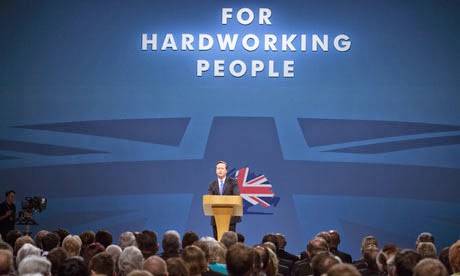 |
| Does David Cameron still have a chance next year? |
This week's poll of polls shows that Labour is unchanged on 33%. The Tories are up 2 points to within a point of Labour, at 32%, UKIP and the Lib Dems both shed a point, on 17% and 7% respectively, and the Greens are up one point to 5%.
It is striking to consider how Labour's poll ratings have declined. Back in 2012, just after George Osborne's now famous "Omnishambles" budget,, the party was polling on 40%, and the Tories were polling just about where they are now. Since then, Labour has seen a slow but steady decline whilst the Tories have remained where they are. My guess would be that the Tories have gained supporters as a result of the economic recovery, but any advantage they will have gained will have been neutralised by the increase in support for UKIP. Labour is, in effect, relying very heavily on Nigel Farage's party maintaining its current levels of support at the General Election.
Overall, most people feel that they are worse off than they were 4 years ago, but only very few believe that they would have been any better off if Labour had remained in power. Labour has still not addressed the core reason for its rejection 4 years ago, which is causing the party some quite significant problems.
Scottish Labour leader Joanne Lamont resigned recently, citing meddling by Westminster colleagues in Scottish Labour affairs.
One wonders whether polling figures like these (The regional extrapolation for Scotland) would also have persuaded her to jump ship.
SNP 43%, Labour 26%, Con 16%, Lib Dems 5%
A result anything like this would lead to a disaster for Labour in Scotland. The party could lose over half of its Westminster seats. Other polling figures listed below are not going to fill Labour figures with confidence either:
The North: Labour 43%, Conservative 28%, UKIP 15%, Lib Dems 8%
The South: Conservatives 38%, Labour 25%, UKIP 20%, Lib Dems 8%
London: Labour 40%, Conservatives 33%, UKIP 12%, Lib Dems 8%
The major issue for Labour is that its support is very heavily concentrated in some of its heartlands; the North and London in particular. In reality, on this kind of share nationally, you would have to rule Labour out from about 10 Tory seats that they would take on a uniform swing, and subtract around 20 seats from the Labour total because of Scotland, plus add 5 UKIP seats that they are likely to take, all from the Tories. That would lead to a total result of something like Labour 298 seats, Conservatives 283, Liberal Democrats 16, UKIP 5, SNP 32, Others 22. That would lead to a hung parliament in which forming a stable government would be very difficult indeed. So, in the last October poll of polls, there's everything still to play for.

Labour are in trouble!
ReplyDelete